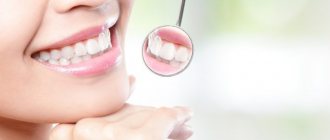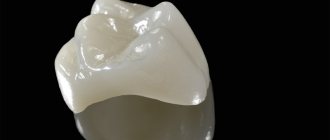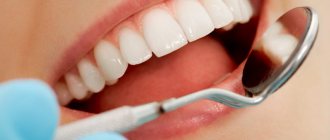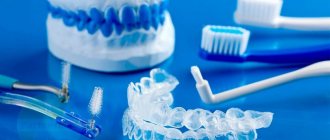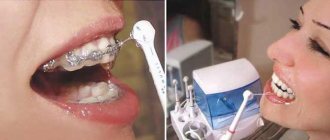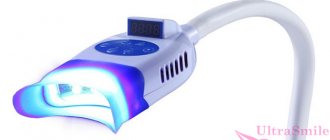Why do teeth darken?
For various reasons, tooth enamel can change from white to yellow, brown, greenish, blue and even purple. The reasons for this process are very different:
- excessive consumption of sweets and starchy foods - bacteria penetrate into microcracks, plaque and tartar appear, teeth change color;
- a persistent yellow tint occurs from products containing pigments (coffee, tea, Coca-Cola and other carbonated drinks);
- damage to the tooth (incomplete dislocation, bruise, fracture of the root or crown) affects the condition of the enamel and its color;
- The hereditary factor also matters;
- in case of systemic hypoplasia of hard tissues or other non-carious diseases, teeth erupt with a changed color;
- Tetracycline teeth with their yellow, brown or gray enamel are also well known (often appear due to the use of a tetracycline antibiotic by the mother during pregnancy).
How does the whitening procedure work?
Before starting the procedure, you should consult your doctor. If you have diseased or untreated teeth, then before whitening you need to solve these problems. Otherwise, the procedure will be extremely painful and will only harm the health of the oral cavity.
To protect the gums, the dentist applies a special gel to them. After that, a teeth whitening preparation is applied to the enamel itself. It contains hydrogen peroxide. This is an aggressive substance and cannot be left on the enamel for a long time. Laser radiation is used to accelerate the penetration of peroxide deep into the dental tissue. Having reached the dentin, the oxidizing agent brightens it and becomes harmless. The procedure lasts no more than 20-30 minutes. The effect is noticeable immediately upon completion of the laser treatment.
After teeth whitening, you need to follow your dentist’s recommendations for some time. Otherwise, the coloring pigments will quickly clog the enamel pores, which will lead to tarnishing.
What can be done
Chemical bleaching is contraindicated up to 15 years, as is hardware bleaching. In childhood, for this purpose, you can use safe folk remedies that have an extremely gentle effect on the tooth:
- lemon juice (after treatment, the mouth must be rinsed with clean water);
- dill and parsley juice;
- cottage cheese, which is also a rich source of calcium and protein;
- strawberries – contain natural whitening agents (it is very important to immediately brush your teeth after the procedure with a fluoride toothpaste, since the berry contains a lot of sugar and acids).
There are other ways to whiten teeth without the help of a dentist. At first glance, they seem quite safe, for example, using hydrogen peroxide or baking soda. However, it is difficult to predict how a child’s fragile enamel will react to such an abrasive effect, especially if parents do not have full confidence in the integrity of the teeth and their health.
What you need to know about teeth whitening and whether you can whiten your teeth at home
Do I need to prepare for teeth whitening?
For teeth whitening, no matter how simple this procedure may seem, you should prepare in advance.
And only a qualified dentist knows what exactly needs to be done for this. First of all, you cannot avoid professional cleaning to remove plaque and stones. Otherwise, bleaching will not help. Of course, all carious cavities should be healed and chronic diseases should be put into remission. To prepare for whitening, your doctor will likely prescribe remineralization therapy, show you how to brush your teeth properly, and tell you what foods to avoid.
Tea, coffee, beets, dark berries, and red wine have a coloring effect on enamel.
A colorless diet is especially important for a week after the procedure, otherwise the effect will be the opposite of what was expected: dyes will easily penetrate under the porous enamel, and after its restoration it will be much more difficult to remove them from there.
And of course, if you smoke, teeth whitening seems like a very dubious undertaking. If you do not give up this bad habit, the enamel will soon darken again.
Are there any contraindications to teeth whitening?
The procedure will not be performed on children under 16 years of age, as well as pregnant and lactating women. Increased tooth wear, periodontitis, periodontal disease and other gum diseases call whitening into question. In addition, contraindications include untreated caries (if the whitening gel gets into the carious cavity, you will experience severe pain) and wearing braces. And if you correct your bite with the help of aligners, then nothing prevents you from resorting to professional home whitening.
If you suffer from tooth hypersensitivity, then you probably shouldn’t do whitening, as it itself can provoke this problem. However, with appropriate preparation - with remineralizing therapy before and enamel fluoridation after - whitening is possible. But only after consultation with a doctor and with his consent.
Is there a difference between at-home and in-office whitening?
First of all, whitening should be divided into professional and non-professional. Professional can be both office (office) and home, or can combine both of these stages.
It is important to understand that in-office whitening has a more aggressive effect: gels contain 30 percent or more of active ingredients (carbamide or hydrogen peroxide), while home gels work more gently, but, of course, not so quickly. They contain 7–10% hydrogen peroxide and 16–22% urea.
The doctor decides which whitening treatment is recommended for you after assessing your oral cavity and general health. That is why we do not recommend purchasing whitening systems for home use at a pharmacy yourself. And if you have already purchased one, be sure to show it to your dentist to avoid complications: tooth hypersensitivity, gum inflammation, enamel damage.
Unfortunately, even in the case of in-office whitening, the result is unpredictable: it depends on the individual characteristics of the body and existing chronic diseases.
For example, the teeth of patients with fluorosis are practically not whitened. Such patients are recommended restoration: veneers, lumineers, crowns.
Are there any benefits to home whitening?
First of all, it is worth highlighting the price: it is often significantly lower than the cost of in-office whitening. In addition, home whitening is more gentle. But you must be disciplined. Once or twice a day for several weeks, you should put on a mouthguard and wear it for the prescribed time. Otherwise, the desired effect will not be achieved.
If you are not confident in your abilities or want to get serious results in a short time, consider the salon option.
Are folk remedies effective?
In order to explain why traditional whitening products do not work, you need to understand the meaning of the salon procedure. And it affects not the enamel of the teeth, but the dentin - the soft layer located under the enamel. Folk remedies for teeth whitening simply cannot penetrate so deeply and act on the surface. The enamel itself is transparent, but the plaque that accumulates on its surface can be more or less colored. It is this that salt, soda, activated carbon and calcium gluconate fight.
Some of the folk remedies are innocent, others, such as soda, can seriously scratch the enamel, because these are abrasives that literally remove plaque from the surface of the tooth.
Yes, teeth sometimes become lighter, but only as a result of getting rid of plaque, nothing more. And if you thoroughly brush your teeth with paste, brush, floss, use a mouthwash and regularly visit the dentist for preventive purposes, then you will not notice the result of such a popular procedure at all.
Special mention should be made about hydrogen peroxide. Yes, it is used both in salon and home whitening products, but in the gel it is no more than 10% in combination with caring, restorative and analgesic components that can reduce tooth sensitivity. Pure peroxide can seriously burn the mucous membranes of the mouth.
If you still want to use folk advice, we can recommend rinsing with very strongly diluted lemon juice, applying lemon zest, strawberry or strawberry puree. However, don't expect miracles from them. These products will not significantly whiten your teeth.
Teeth whitening is a serious procedure that requires a detailed examination of the entire oral cavity, which can only be performed by a doctor. You should not self-medicate under any circumstances, especially when it comes to teeth, because many problems associated with digestion or even the spine are caused by an incorrect bite, increased tooth wear, and enamel defects.
Folk remedies and whitening systems purchased uncontrollably at the pharmacy can not only not help, but also harm your teeth. And if you don’t take care of your oral cavity: don’t visit a hygienist once every six months, smoke, drink a lot of tea and coffee, brush your teeth poorly, then even in-salon whitening can only bring frustration.
100% result guaranteed?
Not always. Firstly, there is a type of teeth on which whitish streaks or spots appear after whitening. For example, with fluorosis - an excess amount of fluoride in the body. Secondly, the lighter the teeth, the less pronounced the effect, and vice versa, the darker the teeth, the more pronounced it is. Thirdly, the individual microstructure of enamel is of great importance. The denser its intercrystalline lattice, the less effective the result will be.
Your dentist will warn you about all the nuances before the procedure, and will also give a forecast for the shade, structure and sensitivity after whitening.
– It is important to understand that after whitening during the first weeks you need to adhere to a “transparent” or “white” diet and give up coloring foods - tea, coffee, berries, some juices, carrots, beets, red wine. It is also important to maintain oral hygiene, and, of course, it is better to forget about smoking. If all recommendations are followed, the whitening effect can last up to 1-2 years.
Is laser teeth whitening harmful?
No. There are a lot of myths that when trying to whiten the enamel, it is damaged. This does not happen with laser exposure. Radiation is necessary precisely so that hydrogen peroxide quickly penetrates to its main site of action, without lingering on the surface layer of the teeth. In this case, the enamel itself is not damaged. It simply does not have time to damage it and immediately penetrates deep into the dentin.
Hydrogen peroxide can burn more delicate tissue – the gums. To prevent such complications, a protective gel is used. It is applied to the gums, which prevents damage to the oral mucosa.
The laser can produce quite strong radiation. However, with laser teeth whitening, there is no overheating of the enamel. The device is equipped with an auto-cooling system, which does not allow the temperature limits to be exceeded during operation.
Is laser teeth whitening harmful? Absolutely not. You will get a snow-white smile without any damage to your health.
Pharmacy preparations for teeth whitening
Currently, there are many products on sale for self-whitening teeth to suit every taste and budget. Before making such a purchase, inquire about the manufacturer and read reviews.
Whitening strips
The standard set includes 28 strips. They must be used every day for two weeks. Place the strip on your teeth and leave it on for 30 minutes. The hydrogen peroxide included in the composition will make your smile a couple of shades lighter.
Whitening Pencil
A very easy to use method. Has the same effect as strips. Squeeze the whitening gel out of the felt-tip pen, apply it to each tooth and leave for the time indicated in the instructions (from 1 to 10 minutes). At the end of the procedure, rinse your mouth with water.
Toothpastes with whitening effect
Toothpaste cannot whiten yellow teeth. It is designed to remove plaque. The abrasive substances and polishing components included in the composition effectively clean the enamel of pigment deposits. However, you cannot use this product constantly: after a week of use, you must take a break for at least two months.
Whitening toothbrush
If the packaging of a toothbrush is marked white or polish, this means that with the help of such a brush you can remove plaque from tea and coffee, as well as polish the enamel, making your teeth smoother and shinier. Of course, you should not expect any whitening effect, but with regular and high-quality cleaning you will return your teeth to their natural shade.
What is cosmetic teeth whitening?
There are different methods of cosmetic whitening, but they all rely on hydrogen peroxide, contained in varying concentrations in the applied gel.
It is this substance that oxidizes the plaque formed on tooth enamel, changing its color.
The intensity of lightening depends on the concentration of peroxide - the higher the content of the active substance, the more lightening can be achieved.
There are also methods that do not involve the use of hydrogen peroxide.
These gels use two substances that release active chlorine, which can also whiten teeth.
The innovative Magic White whitening technology has gained particular popularity in recent years.
It is based on a gel with a fairly small content of hydrogen peroxide.
This makes the procedure less traumatic for tooth enamel.
During exposure, the applied gel reacts with pigments that color the enamel without penetrating into the deeper layers.
The procedure is simple, but requires special equipment, which makes it unsuitable for home use.
- Using a special pearl napkin, teeth are cleaned and the enamel is prepared for further exposure.
- A special gel tray is filled with gel and secured to the teeth.
- The final stage is light exposure - the light of a special lamp is directed onto the teeth, under the influence of which the chemical elements are activated.
Preparation before the procedure does not take more than 15 minutes, and the direct effect of the brightening gel on the teeth lasts 20 minutes. Then the tray with the gel is removed from the jaw.
The cosmetic procedure is painless, and the color becomes 4-10 shades lighter. To achieve the greatest effect, experts recommend 3-5 whitening sessions.
